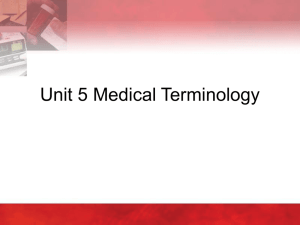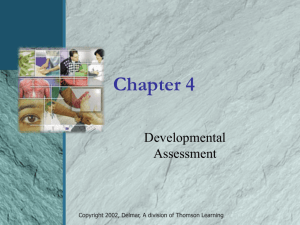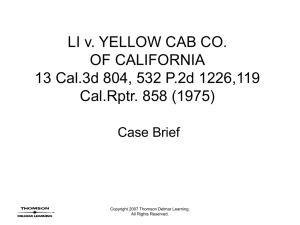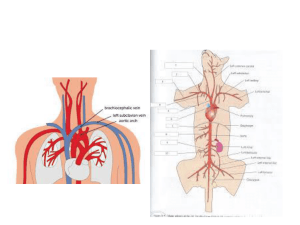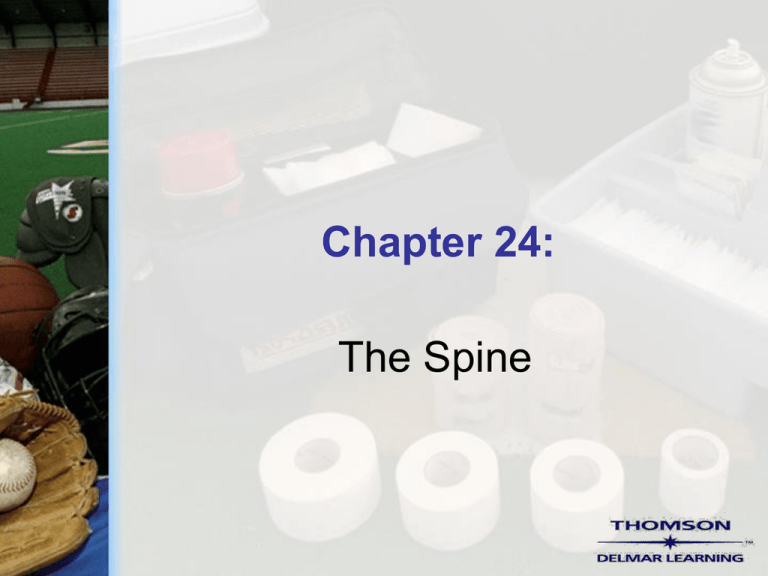
Chapter 24:
The Spine
Reflexes
Many of the body’s reflexes allow
for testing of nervous system
integrity.
Copyright ©2004 by Thomson Delmar Learning. ALL RIGHTS RESERVED.
2
Patellar (Knee-Jerk) Reflex
This commonly tested reflex is
accomplished by tapping the
patellar tendon, which stretches the
quadriceps muscle, stimulating that
muscle’s stretch receptors.
Copyright ©2004 by Thomson Delmar Learning. ALL RIGHTS RESERVED.
3
Patellar (Knee-Jerk)
Reflex (cont.)
A nerve signal is sent to the spinal
cord, which reflects back through a
motor neuron to the quadriceps and
causes contraction.
Quadriceps contraction causes the
lower leg to extend.
Copyright ©2004 by Thomson Delmar Learning. ALL RIGHTS RESERVED.
4
Flexor (Withdrawal) Reflex
This reflex is usually activated in
response to some potentially
injurious stimulus, such as stepping
on a sharp or hot object.
Copyright ©2004 by Thomson Delmar Learning. ALL RIGHTS RESERVED.
5
Flexor (Withdrawal)
Reflex (cont.)
A receptor located in the skin
responds to pain. A nerve signal is
sent to the spinal cord, where it
reflects through a motor neuron to
flexor muscles such as the leg’s
hamstrings, causing the limb to pull
away from the stimulus.
Copyright ©2004 by Thomson Delmar Learning. ALL RIGHTS RESERVED.
6
Plantar Reflex
Tests the integrity of the lower
spinal cord.
A reflex hammer is pulled along the
sole of the foot with pressure
applied.
The normal response is a curling of
the toes.
Copyright ©2004 by Thomson Delmar Learning. ALL RIGHTS RESERVED.
7
Plantar Reflex (cont.)
If damage is present, an abnormal
reflex response is a spreading of
the toes and lifting of the big toe,
also known as Babinski’s sign.
Copyright ©2004 by Thomson Delmar Learning. ALL RIGHTS RESERVED.
8
Nervous System Anatomy
Although other cells help with
support and nourishment, the only
cell that can communicate impulses
to other cells is the neuron.
Copyright ©2004 by Thomson Delmar Learning. ALL RIGHTS RESERVED.
9
Gray and White Matter
Gray matter consists mostly of
neuron cell bodies.
White matter consists mostly of
myelinated nerve fibers.
Copyright ©2004 by Thomson Delmar Learning. ALL RIGHTS RESERVED.
10
Gray and White
Matter (cont.)
Gray matter is found in the center of
the spinal cord and is surrounded
by white matter.
In the brain there is an additional
outer gray matter layer, the cerebral
cortex.
Copyright ©2004 by Thomson Delmar Learning. ALL RIGHTS RESERVED.
11
Spinal Injuries
Trauma to the spine can produce
devastating injuries, including
paralysis and death.
Copyright ©2004 by Thomson Delmar Learning. ALL RIGHTS RESERVED.
12
Jaw-Thrust Maneuver
This is the safest method to restore
breathing when neck injury is
suspected.
The mandible is brought forward by
placing fingers behind the jaw angle
and lifting.
Copyright ©2004 by Thomson Delmar Learning. ALL RIGHTS RESERVED.
13
Intervertebral
Disc Herniation
A structural defect in which the
softer nucleus pulposus protrudes
through the tough annulus fibrosus
Copyright ©2004 by Thomson Delmar Learning. ALL RIGHTS RESERVED.
14

